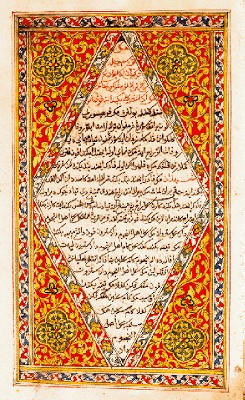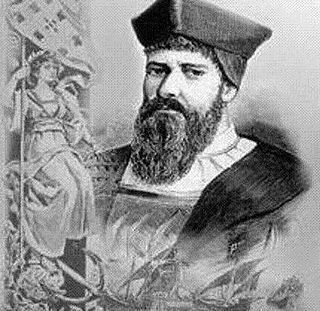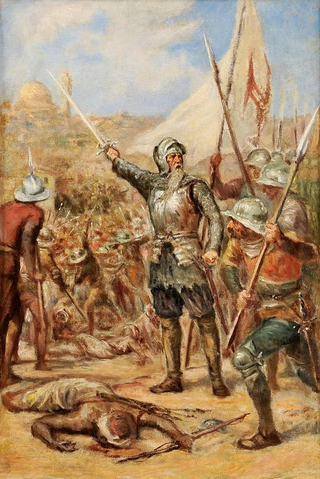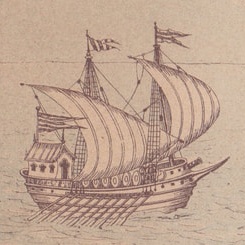
Afonso de Albuquerque, 1st Duke of Goa, was a Portuguese general, admiral, and statesman. He served as viceroy of Portuguese India from 1509 to 1515, during which he expanded Portuguese influence across the Indian Ocean and built a reputation as a fierce and skilled military commander.

Manuel I, known as the Fortunate, was King of Portugal from 1495 to 1521. A member of the House of Aviz, Manuel was Duke of Beja and Viseu prior to succeeding his cousin, John II of Portugal, as monarch. Manuel ruled over a period of intensive expansion of the Portuguese Empire owing to the numerous Portuguese discoveries made during his reign. His sponsorship of Vasco da Gama led to the Portuguese discovery of the sea route to India in 1498, resulting in the creation of the Portuguese India Armadas, which guaranteed Portugal's monopoly on the spice trade. Manuel began the Portuguese colonization of the Americas and Portuguese India, and oversaw the establishment of a vast trade empire across Africa and Asia. He was also the first monarch to bear the title: By the Grace of God, King of Portugal and the Algarves, this side and beyond the Sea in Africa, Lord of Guinea and the Conquest, Navigation and Commerce in Ethiopia, Arabia, Persia and India.

Tristão da Cunha was a Portuguese explorer and naval commander. In 1499, he served as ambassador from King Manuel I of Portugal to Pope Leo X, leading a luxurious embassy presenting in Rome the new conquests of Portugal. He later became a member of the Portuguese privy council.
Fernão Pires de Andrade was a Portuguese merchant, pharmacist, and diplomat who worked under the explorer and colonial administrator Afonso de Albuquerque. His encounter with Ming China in 1517—after initial contacts by Jorge Álvares and Rafael Perestrello in 1513 and 1516, respectively—marked the resumption of direct European commercial and diplomatic contact with China.

Hang Tuah is said to have been a warrior who lived in Malacca during the reign of Sultan Mansur Shah in the 15th century. There is limited historical evidence for his existence. However, he supposedly was a great laksamana, or admiral, a diplomat and a silat master. Hang tuah is the most illustrious warrior figure in Malay literature. He is however, a somewhat controversial figure and there is much in dispute about the factual basis of Hang Tuah's story.

The Malay Annals, originally titled Sulalatus Salatin, is a literary work that gives a romanticised history of the origin, evolution and demise of the great Malay maritime empire, the Malacca Sultanate. The work, which was composed sometime between the 15th and 16th centuries, is considered one of the finest literary and historical works in the Malay language.

João da Nova was a Spanish-Galician explorer of the Atlantic and Indian Oceans at the service of Portugal. He is credited as the discoverer of Ascension and Saint Helena islands.

This is a historical timeline of Portugal's Second Dynasty.

The Lantaka also known as rentaka was a type of bronze portable cannon or swivel gun, sometimes mounted on merchant vessels and warships in Maritime Southeast Asia. It was commonly equipped by native seafaring vessels from the Philippines, Indonesia, Brunei, and Malaysia. Lela and rentaka are known by the Malays as meriam kecil, the difference is that rentaka is smaller in length and bore than a lela. and Lantakas are often called Kanyon in Filipino.

NRP Afonso de Albuquerque was a warship of the Portuguese Navy, named after the 16th-century Portuguese navigator Afonso de Albuquerque. She was destroyed in combat on 18 December 1961, defending Goa against the Indian Armed Forces Annexation of Goa.

Portuguese maritime exploration resulted in the numerous territories and maritime routes recorded by the Portuguese as a result of their intensive maritime journeys during the 15th and 16th centuries. Portuguese sailors were at the vanguard of European exploration, chronicling and mapping the coasts of Africa and Asia, then known as the East Indies, and Canada and Brazil, in what came to be known as the Age of Discovery.
António de Saldanha was a Castilian-Portuguese 16th-century captain. He was the first European to set anchor in what is now called Table Bay, South Africa, and made the first recorded ascent of Table Mountain.

The Portuguese conquest of Hormuz in 1507 occurred when the Portuguese Afonso de Albuquerque attacked Hormuz Island to establish the Fortress of Hormuz. This conquest gave the Portuguese full control of the trade between India and Europe passing through the Persian Gulf.

The Capture of Malacca in 1511 occurred when the governor of Portuguese India Afonso de Albuquerque conquered the city of Malacca in 1511.

The Portuguese conquest of Goa occurred when the governor Afonso de Albuquerque captured the city in 1510 from the Adil Shahis. Goa became the capital of the Portuguese State of India which included possessions such as Fort Manuel, the territory of Bom Bahia, Damann and Chaul. It was not among the places Albuquerque was supposed to conquer. He did so after he was offered the support and guidance of Timoji and his troops. Albuquerque had been given orders by Manuel I of Portugal to capture Ormus, Aden and Malacca only. Goa would remain under Portuguese control until 1961.
The Fifth India Armada was assembled in 1503 on the order of King Manuel I of Portugal and placed under the command of Afonso de Albuquerque. It was Albuquerque's first trip to India. It was not a particularly successful armada - navigational mistakes scattered the fleet on the outward journey. Ships spent much time looking for each other and several ended up travelling alone.
Diogo Fernandes Pereira, sometimes called simply Diogo Fernandes, was a Portuguese 16th-century navigator, originally from Setúbal, Portugal. Diogo Fernandes was the first known European captain to visit the island of Socotra in 1503 and the discoverer of the Mascarenes archipelago in 1507. He may also have been the first European to sail east of Madagascar island.

António de Abreu was a 16th-century Portuguese navigator and naval officer. He participated under the command of Afonso de Albuquerque in the conquest of Ormus in 1507 and Malacca in 1511, where he got injured. Departing from Malacca in November 1511 with four ships, in an exploratory voyage to the 'Spice Islands' of Maluku, he led the first European expedition to reach Timor and the Banda Islands, in Indonesia, in 1512.

Lela or lila is a type of Malay cannon, used widely in the Nusantara archipelago. They are similar to a lantaka but longer and had larger bore. Lela can be configured as swivel gun, fixed gun, or mounted in a gun carriage. It is the equivalent of European falcon and falconet.

Mendam Berahi was a legendary royal galley said to be used by the Malacca Sultanate in the 16th century. The ship was under the control of Admiral Hang Tuah when he traveled to fourteen countries or cities. The ship was also used to establish relations with other countries, conduct trade, and transportation, which included bringing pilgrims to Mecca. A trip to Mecca lasted months and required a constant supply of food. However, Mendam Berahi could not transport food, water, and other necessities in large quantities, so the ship had to stop at ports to get supplies and shelter from poor weather. Records of the ship are only found in the Hikayat Hang Tuah, and other Malay accounts such as the Malay Annals do not record it. The Hikayat Hang Tuah was written after the 17th century,, so the information presented in it may be inaccurate. Hikayat Hang Tuah notes that the story of Hang Tuah is in the same timeline as Raden Inu from the Janggala Kingdom (1045–1136) which actually comes from the Javanese Panji tales. Portuguese accounts do not record Mendam Berahi either, although Tomé Pires' Suma Oriental contains references to a large ship, where he mentions a "flagship" of Malacca which carried many bombards. This ship, however, is not necessarily Mendam Berahi, and could be another ship.

















